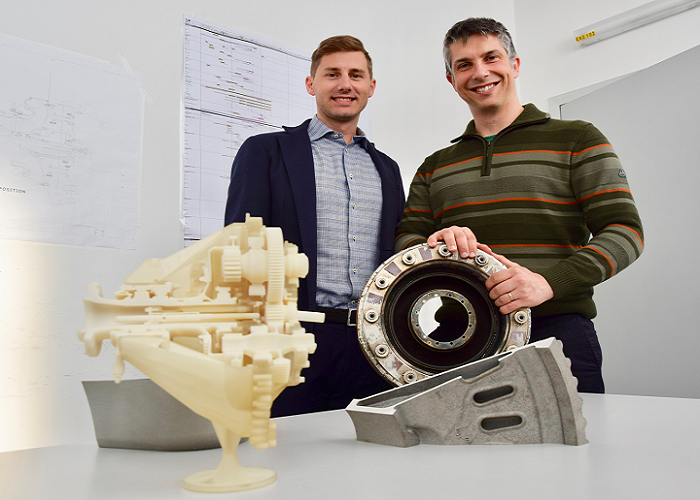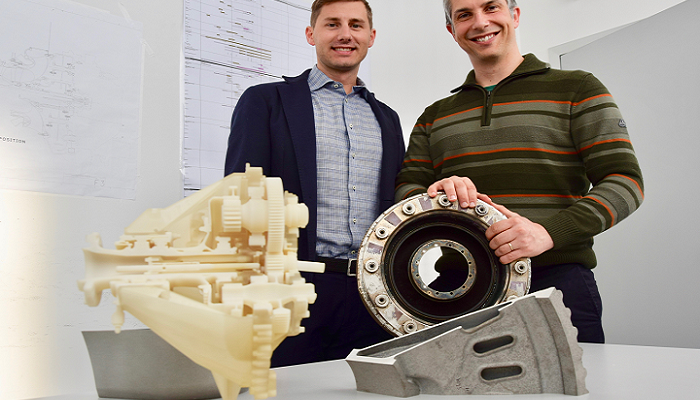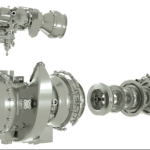

A new entry from GE Reports breaks down how 3D printing technology is responsible for a new era in the field of aircraft design, and GE Aviation has been along on the ride for years. The General Electric subsidiary, one of the top aircraft engine suppliers in the world, has long been using 3D printing technology to make components for its jet engines, including the FATE engine and the ATP engine. In December, GE Aviation began testing a new advanced turboprop engine called the GE Catalyst, which is special because over one third of it will eventually be 3D printed using a variety of metals.
The parts are all being printed at GE Aviation’s 150,000-square-foot Additive Technology Center (ATC) in Cincinnati, which is one of the world’s largest, most advanced AM factories. 300 designers, engineers, and technicians work at the ATC, operating over 75 3D printers – including six of the largest in the world.
“I was a little skeptical at first because the technology is so new. But when I finally went there, I was completely astonished,” said Massimo Giambra, an engineer at Italian company Avio Aero, which was acquired by GE Aviation five years ago.
Giambra and his fellow employee, Fabrizio Bussi, design some of the most important parts for the GE catalyst engine, including the accelerator, a combustor swirler that mixes fuel with air in the engine, a gearbox, and a large gearbox case that’s nearly the size of a lampshade. The parts are sizable, each one weighing several pounds, but they’d be even heavier if it weren’t for 3D printing technology.
It can be hard to achieve complex geometries and internal shapes using traditional manufacturing techniques, such as milling and drilling, to finish parts. But metal 3D printers are able to print hollow, intricate shapes, like lattices. For instance, the 3D printed gearbox cover has tiny ridges and ribs on the surface for structural strength; however, these also allowed Bussi to make the walls as thin as a single millimeter. The component now weights 15-20% less than a traditional part would.
Bussi said, “We were able to achieve thickness that would be impossible with forging and casting.”
As with many engineers currently on the job, Giambra and Bussi did not study 3D printing in university courses. According to Giambra, this is not uncommon.
“No one did. When I was getting my engineering degree, there was not a single additive course,” Giambra explained. “We are all learning on the job.”

3D printing allows the engineers to 3D print viable prototypes, test them, iterate the design, and repeat the whole process in just weeks, which majorly decreased the development process.
“You don’t have to follow some true-and-tried path because it’s always been done that way. Additive is so new and so revolutionary,” Bussi said. “When you embrace it, it frees your mind and frees your hands. It’s exhilarating.
“In the past, design engineers were always asking themselves: Can the factory actually make this? Those constraints are gone, and shapes that in the past looked too fancy are perfectly possible now. The benchmark for us now is achieving the most optimal design.”
The technology also makes it possible to develop designs that were originally not feasible, or too expensive, to make. Using conventional manufacturing methods, the combustor swirler is built from four components, but 3D printing allows the part to be built as a single piece, which saves a lot of time.
Giambra said, “For me, there’s absolutely no comparison to traditional forging and machining. Now you have one machine for everything, no more expensive casting and forging forms or specialized machines.”
According to the two engineers, both GE Aviation and Avio Aero had a head start in 3D printing technology. In 2012, GE Aviation acquired Cincinnati-based AM pioneer Morris Technologies, while the Italian company acquired 3D printing shop ProtoCast ten years ago. Avio Aero has also partnered with polytechnic universities in the Italian cities of Bari and Turin in an effort to develop new 3D printing applications and find new ways to work with metal 3D printing powders, as well as develop a lab for additive repair solutions and one for studying metal powders and AM processes.
But the journey to AM development isn’t over yet. Avio Aero plans to open a new additive facility inside its Brindisi plant in southern Italy, which will print parts for the new GE Catalyst engine using 3D printers from Concept Laser, another GE acquisition.
Bussi said, “We knew that this isn’t going to be an easy journey and we are still at the beginning. But we are all working together, in Europe and in the U.S., and the results have been amazing.”
Using 3D printing technology, engineers will be able to combine 855 separate parts for the GE Catalyst into only 12. Combined with digital controls so pilots can fly commercial turboprop planes like jets, this amazing breakthrough will give the engine 10% more power when compared with other engines in its class, and reduce fuel burn by as much as 20%. The first plane to be powered by this new engine and its 3D printed components will be the Cessna Denali.
Discuss this and other 3D topics at 3DPrintBoard.com or share your thoughts below.
When it comes to 3D real estate visualization in the USA, our service provides the perfect solution for bringing property listings to life. Through our platform, you can easily access cutting-edge 3D renderings that showcase your real estate projects in a way that attracts potential buyers and investors. Whether it's residential, commercial, or mixed-use properties, our team of experts uses advanced technology to create immersive visualizations that highlight the best features of your property, making it easier for clients to imagine the space as their own.
Through our website, you can quickly get high-quality 3D real estate visualizations that are tailored to your specific needs. With our help, you'll stand out in the competitive real estate market by offering potential buyers a realistic, interactive view of your property. Our efficient process ensures a fast turnaround time, while our attention to detail guarantees that every aspect of the property is represented accurately, giving you a powerful marketing tool to promote your real estate listings.






